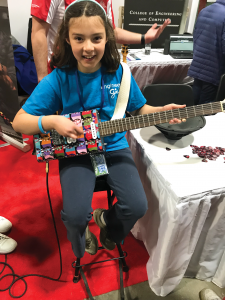Simil Raghavan is attracting more young people to engineering with an innovative program that puts women at the centre of the profession.
“What do you want to be when you grow up?” It can be a tough question, particularly when a good answer might be obscured by a host of misconceptions.
That was the case for Dr Simil Raghavan, Program Officer at The National Academy of Engineering in the United States, and manager of the academy’s Online Ethics Center and its EngineerGirl program.

“My career is a little bit unusual, but I don’t know that it’s that unusual for a young woman trying to figure herself out,” Raghavan told create.
Wanting to make a positive impact but not knowing where her talents might be applied, she worked at a school for deaf children for three years after finishing high school before heading to university and switching from education to social work and languages.
“I wanted to help kids like the ones I had been working with, which maybe wasn’t the best choice considering I thought I would burn out in education,” she explained, adding that a lecturer told her that social work might not be the best match either.
“She finally got frustrated with me and said, ‘Simil, you think too much. If you’re going to be a good social worker, you’re going to have to learn to do what you’re told’. A light bulb went off in my head and I thought, ‘I’ll never be good at this’.”
A “kind of crisis” in the school cafeteria was followed by a suggestion she apply her love of maths and science to an engineering course.
It was the right path, and Raghavan eventually finished her education with a PhD in biomedical engineering from Johns Hopkins University. She might have been spared a lot of frustration if somebody had answered another old question — “What do engineers do?” — for her early on.
Nowadays, a large amount of her time is dedicated to answering that question through the EngineerGirl program, which focuses on an audience of middle school girls.
The EngineerGirl website has been running since 2001. It lets visitors know about the profession through FAQs, its Gallery of Women Engineers, explanations from mentors in the Ask An Engineer section, and an Ambassador Program, featuring high school-aged ambassadors.
Creating the future
An enduring and successful part of the program is an annual essay-writing competition. ‘Coopertition’ programs have helped get students hooked on STEM. However, a challenge to build a device in a workshop with a group might not be an activity with which every young girl feels at home.
“Writing is something that, not for every girl, but that a lot of girls seem to have more confidence in; girls tend to develop their language skills earlier, so sometimes they will be much more confident in writing an essay,” Raghavan said.
“And this addresses that one issue I talked about where I got into college and said, ‘What does an engineer do?’ It’s a lower door than jumping into a design challenge or something like FIRST Robotics.”
The competition runs with a different theme each year and gives entrants a taste of ideas like engineering design.
The categories encompass elementary (grades 3-5), middle (6-8) and high (9-12) school levels.
This year, the competition debuts a creative fiction task, which must feature a female hero who saves the day with her engineering chops.
According to EngineerGirl’s polling, more than 40 per cent of the program’s participants say the experience caused them to consider an engineering career and 90 per cent say they learned something about or changed their views about engineering.
Asked about success stories, Raghavan mentions Gitanjali Rao, who won the 2016 Grade 3-5 division with an essay on cybersecurity and biometrics.
Rao could be a name to watch; the then 11-year-old won the Discovery Education 3M Young Scientist Challenge last year with a device for detecting lead contamination in water using carbon nanotube sensors.
The competition is also open to boys, who have made up roughly a fifth of entrants.
Raghavan said the reasons for the gender imbalance among engineering students at university are numerous. However, she says, from the beginning, young girls aren’t told the right thing about the profession — if they’re told anything at all.
Gitanjali Rao.Around 20 per cent of engineering bachelor’s degrees completed in the US are awarded to women, a rate slightly better than Australia’s 14 per cent.
“When I think back on the one experience … one of those things is that nobody ever suggested engineering to me,” she said.
“The other [thing] is the expectation of what girls will do. You’re told from the beginning that it’s important to help people and I think a lot of girls grow up want to do that: they want to change the world, they want to make a difference. And engineering is not — or at least hasn’t traditionally been— marketed that way.”
This article originally appeared as “Great expectations” in the March 2019 issue of create magazine.
